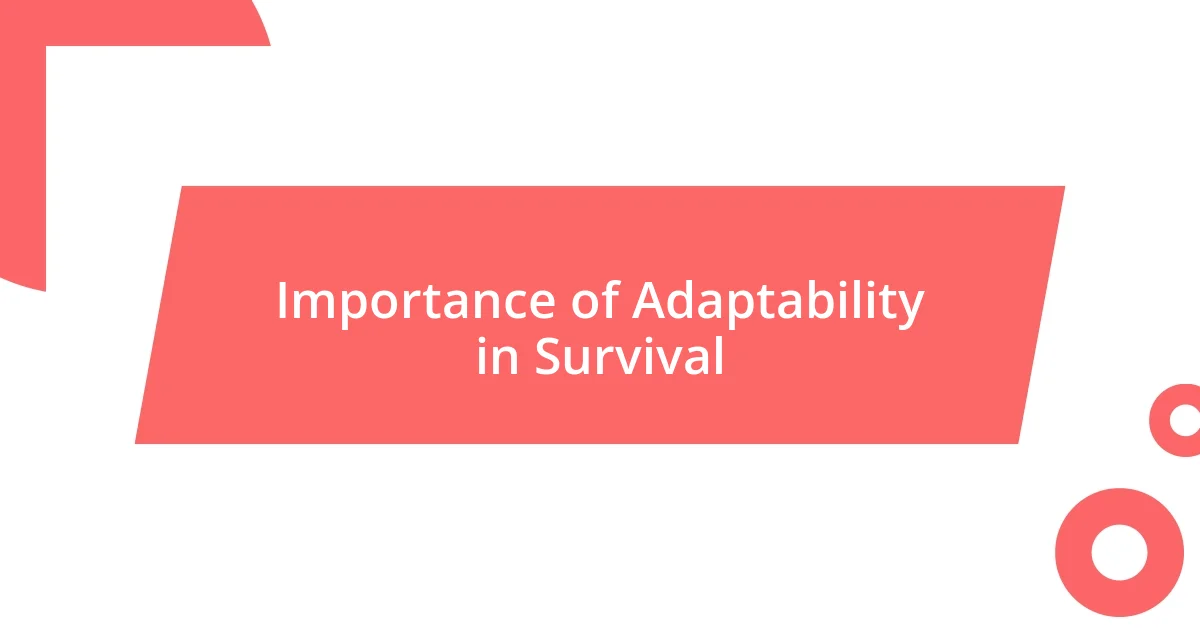Key takeaways:
- Agile survival skills encompass both physical adaptability and mental resilience, enabling individuals to effectively respond to unexpected challenges in nature and life.
- Key survival techniques include fire-making, foraging, shelter-building, navigation, and first aid, which enhance confidence and readiness in outdoor situations.
- Trusting instincts, prioritizing information, and maintaining a positive mindset are crucial for making quick decisions during survival scenarios and transforming crises into learning experiences.

Understanding Agile Survival Skills
Agile survival skills are essential for adapting to ever-changing environments. I remember a time when I found myself stranded in the wilderness after a sudden storm disrupted my plans. It was in that moment of chaos that I realized how important it is to think on your feet and make quick decisions about shelter and resources. Have you ever faced a similar situation where your instincts kicked in?
These skills encapsulate not only physical adaptability but also mental resilience. For me, mastering skills like fire-making or foraging gave me a profound sense of confidence. It’s fascinating how these abilities can transform panic into power. Can you recall a moment when you’ve had to rely on your own resourcefulness?
Furthermore, understanding agile survival skills is about embracing uncertainty. Nature won’t always follow a predictable pattern, just like life itself. I often find solace in the unpredictability of outdoor adventures; it teaches you to assess risks and pivot quickly. Isn’t it empowering to know that with the right skills, we can navigate not just the wilderness but also our own life challenges?

Importance of Adaptability in Survival
Being adaptable in survival situations can make all the difference between life and death. I recall a particularly chilly night I spent outdoors when my planned campsite turned out to be in the path of a looming fog. Instead of panicking, I adapted by finding a new location and using the available materials to build a makeshift shelter. This experience underscored for me that the ability to pivot in the face of adversity is not just a skill—it’s a necessity.
When you think about survival, consider the unpredictable variables nature throws our way. I remember a hike where I had to pause due to an unexpected wildlife encounter. Rather than panicking, I utilized my knowledge of animal behavior to quietly back away and find a safer path. This adaptability didn’t just help me in that moment— it reinforced my belief that awareness and flexibility empower us to integrate our knowledge with the conditions at hand.
The essence of adaptability is rooted in resilience and confidence. Anytime I approach a tough situation, like when I once got lost in a dense forest, my first step is to breathe deeply and assess my surroundings. This mindset allows me to remain calm and ultimately devise a plan. Wouldn’t you agree that being adaptable gives you the power to turn potential crises into opportunities for growth and learning?
| Traditional Approach | Agile Approach |
|---|---|
| Rigid planning and set procedures | Flexible, responsive decision-making |
| Reliance on pre-set tools | Utilizing available resources creatively |
| Fear of mistakes | Embracing failures as learning experiences |

Essential Skills for Outdoor Survival
Acquiring essential outdoor survival skills is about more than just knowledge; it’s deeply tied to your experiences in the wild. One time, while attempting to start a fire in damp conditions, I felt the frustration creep in. I paused, took a breath, and remembered that improvisation can be key. Utilizing dried leaves and small twigs I found nearby, I managed to create a spark. The sheer joy of that fire flickering back to life taught me that resilience in the face of challenges is invaluable.
Here are some crucial skills that every outdoor enthusiast should develop:
- Fire-making: Knowing how to create a fire, even in adverse weather, can warm you, cook food, and signal for help.
- Shelter-building: The ability to construct a shelter using natural materials can protect you from the elements when you’re caught off guard.
- Foraging: Identifying edible plants and berries can supplement your food sources and provide essential nutrients.
- Navigation: Mastering basic navigation skills, such as using a map and compass, ensures you can find your way in unfamiliar terrain.
- First aid: Understanding basic first aid can be lifesaving in emergencies, allowing you to treat injuries or illnesses quickly.
In my experience, practicing these skills ahead of time enhances confidence and readiness. I recall trekking with friends, reminding them that knowledge of these skills isn’t just academic; it’s practical and deeply empowering. With each lesson learned, I found my anxiety about wilderness encounters slowly morphing into excitement—a thrilling sense of adventure waiting to unfold.

Techniques for Quick Decision Making
When making quick decisions in survival situations, one technique I’ve relied on is the “80/20 rule.” It’s fascinating how often I’ve found that 80% of the information I think I need isn’t as crucial as that vital 20%. I remember a time when I had to choose between two different water sources while stranded. Focusing on a few key indicators, like clarity and proximity to my location, helped me make a swift and effective decision without getting bogged down by unnecessary details. How do you prioritize information in moments of pressure?
Another effective approach is to visualize possible outcomes. During one particularly intense backpacking trip, I faced a sudden storm while setting up camp. I took a moment to imagine each scenario: staying put, relocating, or seeking shelter. By picturing the possible results of my choices, I quickly understood that moving to higher ground would be my best bet. Embracing the power of visualization gave me clarity when I needed it most. Have you ever considered how visualization could impact your decision-making process?
Finally, trust in your instincts. I’ve learned that sometimes, my gut feeling is the best compass I have. On one occasion, I hesitated at a crossroads while hiking; something didn’t feel right about one of the paths. Choosing to trust that instinct saved me from wandering into an area known for treacherous terrain. It’s a reminder that honing our intuition can be just as important as any learned skill. Isn’t it interesting how our inner voice often knows more than we realize?

Tools to Enhance Survival Efficiency
When it comes to tools that enhance survival efficiency, one item I’ve learned to never underestimate is a quality multi-tool. I vividly recall a trip when I found myself needing various implements: a knife for food prep, scissors for cordage, and even a flathead screwdriver to repair gear. Having that multi-tool not only saved me time but also reduced the number of items I had to carry. Isn’t it amazing how something compact can provide so many solutions in critical moments?
Moreover, a reliable fire starter is a non-negotiable in any survival kit. On one particularly chilly evening, I struggled to get a fire going with only matches and damp tinder. It was the moment I pulled out a magnesium fire starter that everything changed. With just a few strikes, a spark lit up the night, warming me up and lifting my spirits. Can you recall a time when a simple tool turned a frustrating experience into a moment of triumph?
Lastly, let’s not overlook the importance of a quality first aid kit. Once, while hiking, a sharp branch snagged my leg, leaving a nasty cut. Thankfully, I had my well-stocked first aid kit, which quickly provided antiseptic wipes and bandages. The relief in that moment felt profound—knowing I had the means to care for myself. Do you ever think how having the right tools can make all the difference in a survival situation? Being prepared allows us to focus on the adventure rather than potential setbacks.

Practical Scenarios for Agile Responses
Being prepared for unpredictable situations can make all the difference. I recall a hike when an unexpected avalanche warning caused a surge of adrenaline. I had to quickly decide whether to turn back or find shelter. By assessing the terrain and weighing the potential risks against the urgency of a safe retreat, I chose to move to a more stable area, which ultimately kept me safe. Have you ever had to make a split-second decision that felt like life or death?
Another instance that stands out to me was during a canoeing trip when I found myself caught in turbulent waters. The current was strong, and options seemed limited. Drawing on my survival training, I quickly assessed my surroundings and noticed a cluster of overhanging trees. I aimed for them, using the natural barrier to pull myself to safety. In that moment, relying on my agile responses not only saved me but also transformed a moment of panic into a story I now cherish. Has there been a moment in nature when quick thinking turned a challenge into an adventure?
One of the most poignant scenarios I experienced involved navigating through dense fog while backpacking alone. Visibility was nearly zero as I trekked, making it impossible to see even a few feet in front of me. I had to trust my map and compass, feeling a rush of anxiety mixed with determination. Each step felt monumental, and I vividly remember the sense of relief when I emerged from the fog and back into clarity. It’s incredible how our minds can adapt in moments of uncertainty. What’s your experience with facing challenges when visibility or clarity was compromised?

Lessons Learned from Survival Experts
I’ve had the fortunate opportunity to learn from survival experts who emphasize the significance of observation in nature. One lesson that resonated deeply with me was how small changes in an environment can indicate larger threats, like sudden gusts of wind signaling an approaching storm. I remember hiking when I noticed the leaves rustling intensely just before rain set in. This awareness not only prepared me for what was coming but also instilled a deeper respect for nature’s signals. Have you ever taken a moment to pause and really listen to your surroundings?
Another valuable insight I gathered is the importance of maintaining a positive mindset. There’s a story from an expert I admire who recounted a survival scenario where he was lost for days but focused on small victories: every blaze he found, every sip of water he conserved. I’ve drawn on similar experiences in my own journeys, using affirmations to encourage myself when things feel dire. It’s amazing how a shift in perspective can transform anxiety into action. Do you remember a time when positivity propelled you through a tough situation?
Finally, I can’t stress enough how vital adaptability is in survival situations. I once participated in a workshop where an expert demonstrated how to use everyday items in unexpected ways. For instance, he turned a shoelace into a tourniquet when someone accidentally cut themselves. This had a profound impact on me—learning to be versatile with what we have on hand can mean the difference between safety and danger. Have you ever had to improvise when plans changed in an unexpected way? It’s these moments that often teach us the most.















